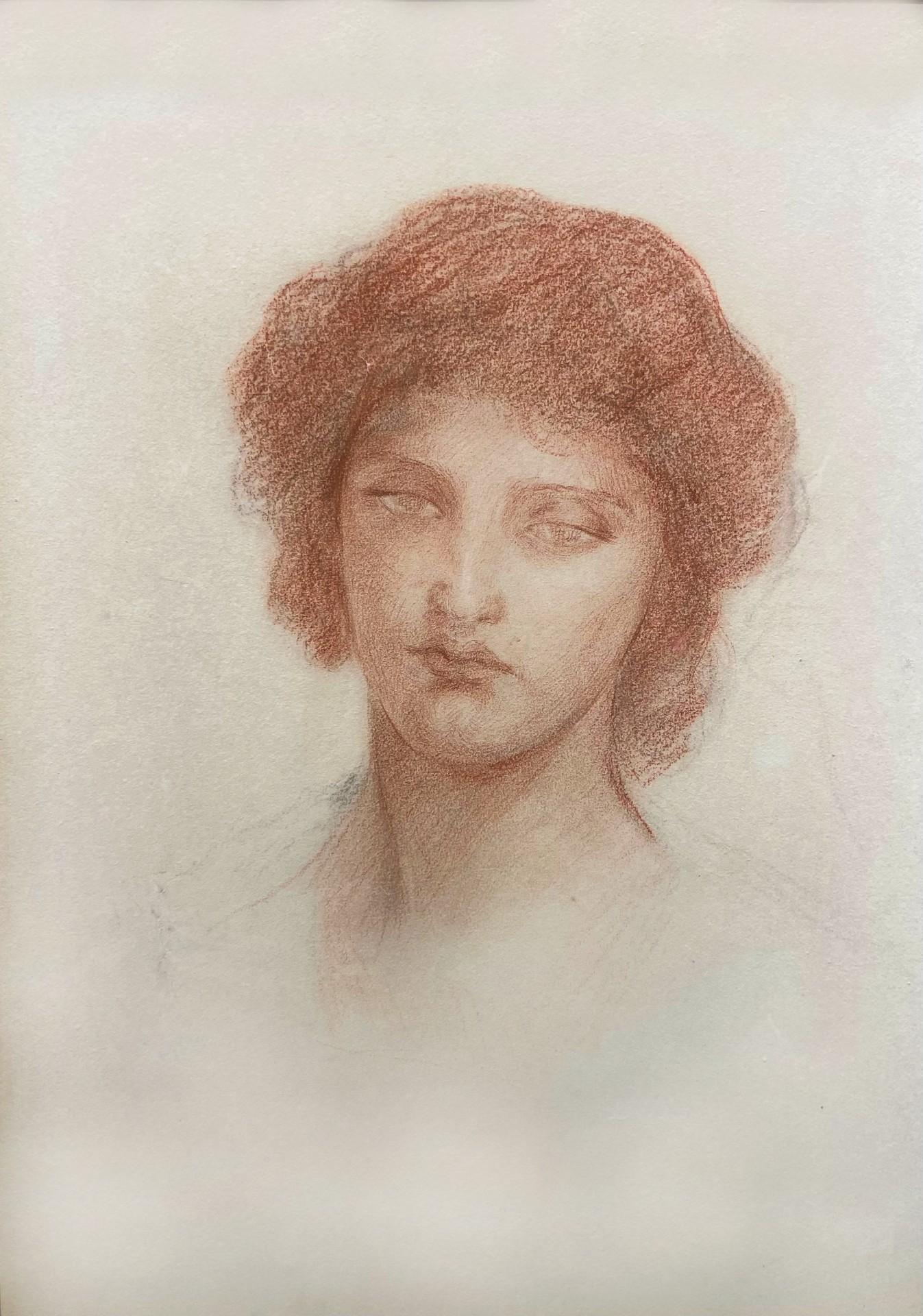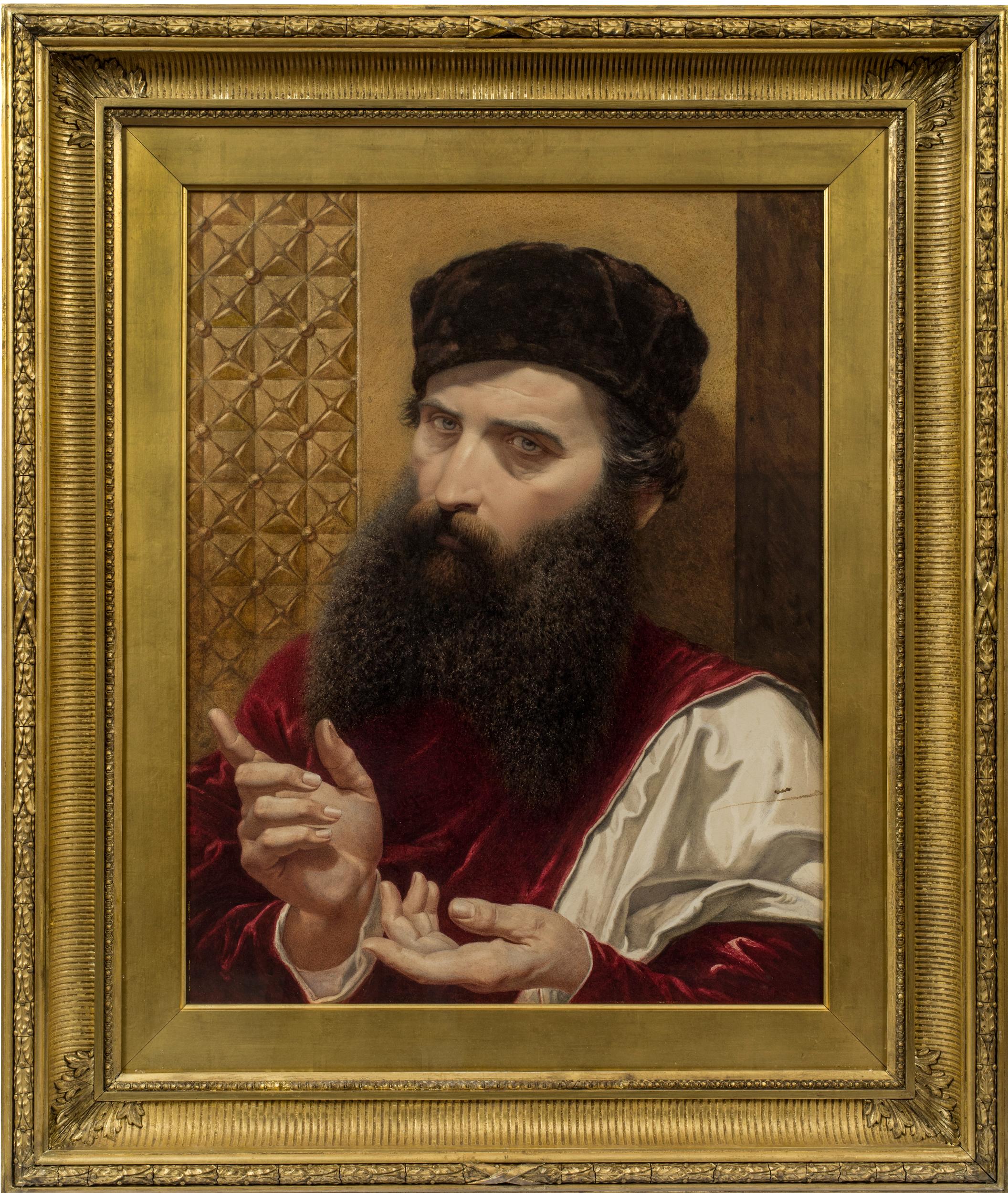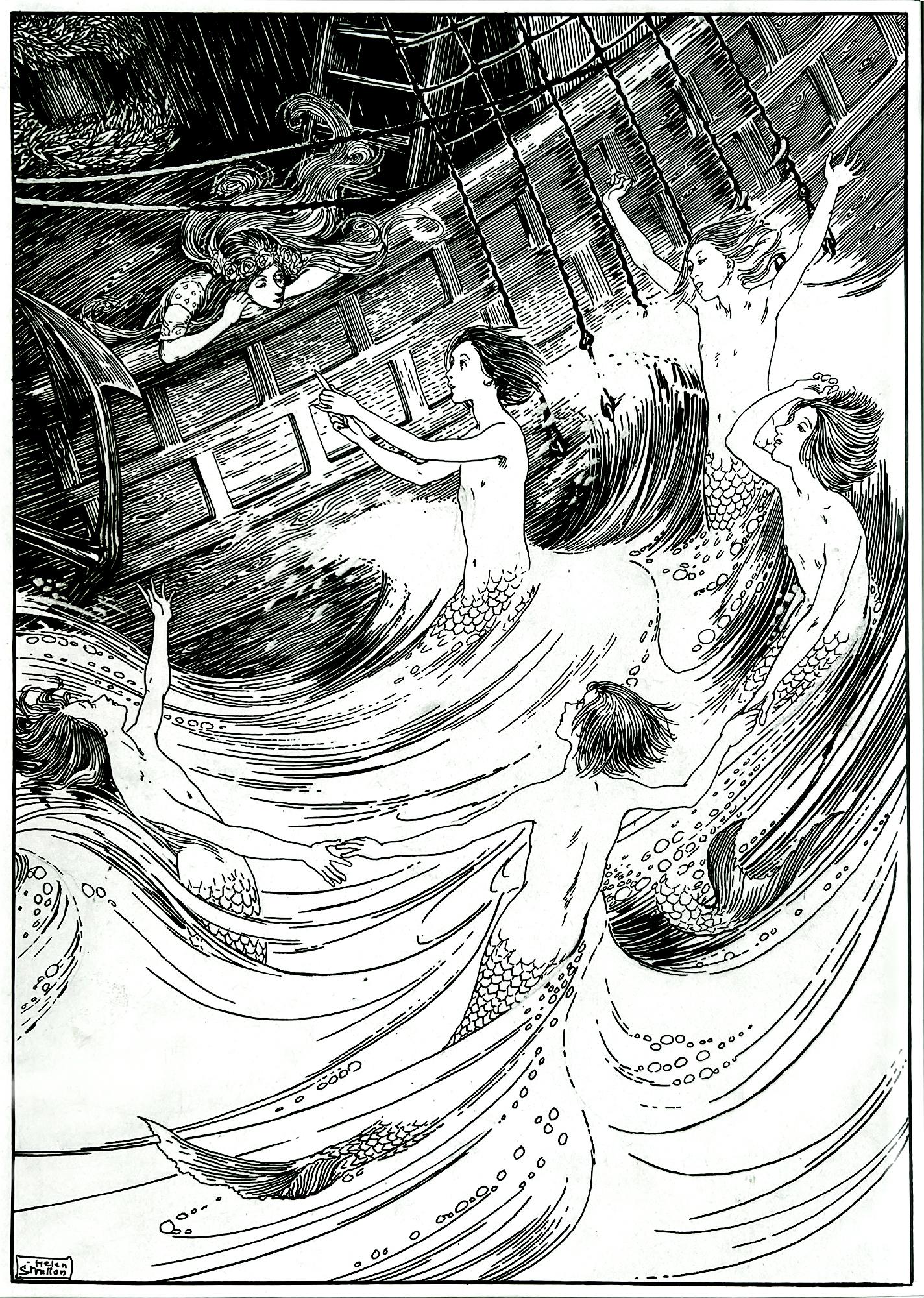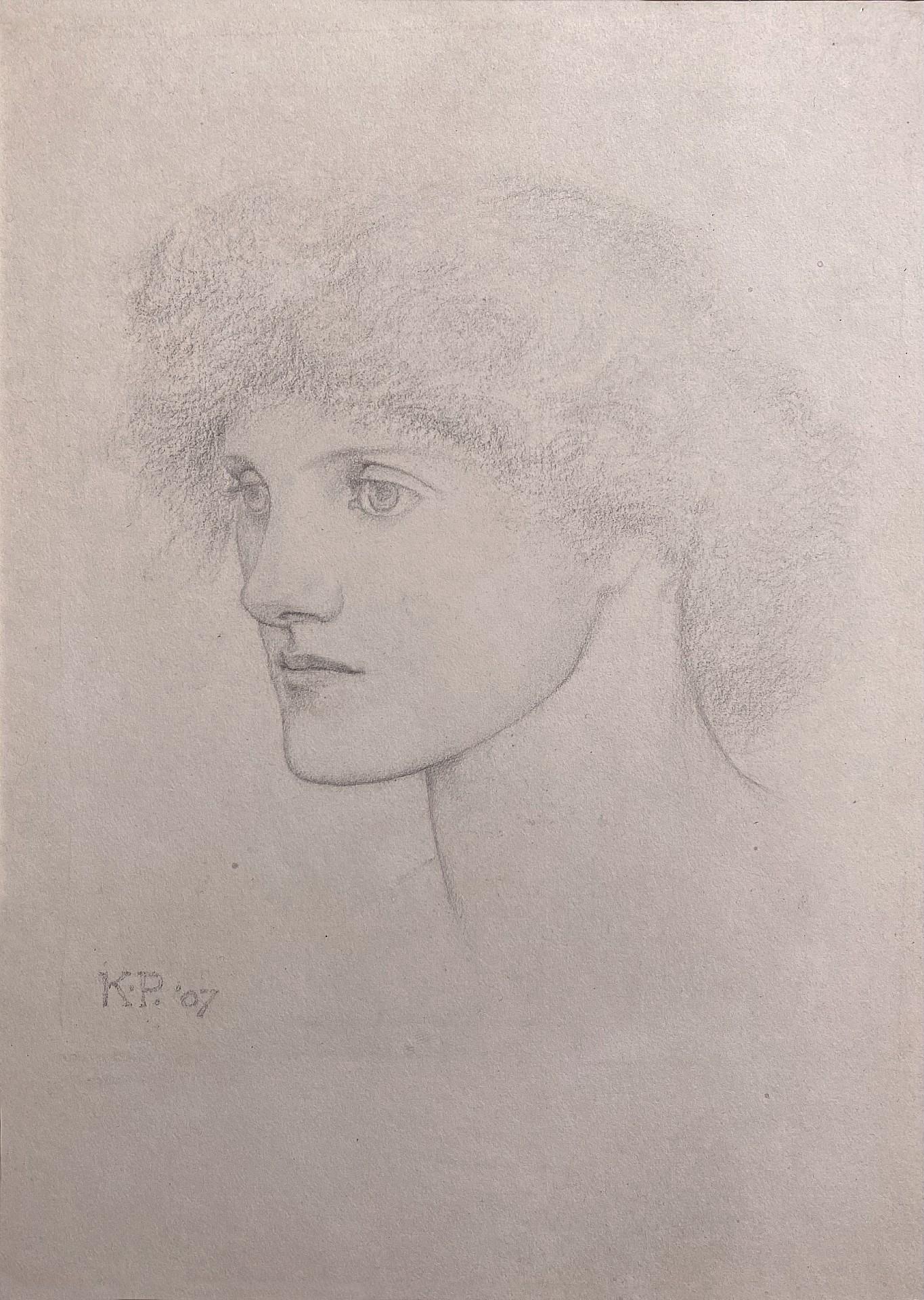Items Similar to Portrait of Mildred - British Victorian art Pre-Raphaelite seated young girl
Want more images or videos?
Request additional images or videos from the seller
1 of 14
Edward Robert HughesPortrait of Mildred - British Victorian art Pre-Raphaelite seated young girl1885
1885
About the Item
This captivating Victorian sanguine portrait drawing of a young girl is by Pre-Raphaelite British artist Edward Robert Hughes. The red chalk portrait dated 1885 is of Mildred, her name inscribed upper left. She is seated, hands in lap, her long hair flowing over her shoulders in typical Pre-Raphaelite manner. Great detail has gone into depicting the smocking on her dress and the artist has perfectly captured her sweet innocent nature.
Signed and dated lower left.
Provenance. Cambridge collection.
Condition. Red chalk on paper, image size 22 inches by 18 inches and in good condition.
Housed in a complimentary frame and glazed, 28 inches by 24 inches framed and in very good condition.
Edward Robert Hughes - Not to be confused with Edward Hughes (1832 - 1908), who specialised in portrait painting. Edward Robert Hughes RWS (1851 – 1914) was an English painter who worked prominently in watercolours, but also produced a number of significant oil paintings. He was influenced by his uncle and eminent artist, Arthur Hughes who was associated with the Pre-Raphaelite Brotherhood, and worked closely with one of the Brotherhood's founders, William Holman Hunt. Having settled on his career choice, Edward Robert Hughes attended Heatherley's in London to prepare himself for the chance of auditioning for the Royal Academy School. Hughes became a student at the Royal Academy School in 1868. While Pre-Raphaelitism played an influential part in shaping Hughes work, Aestheticism is also seen in his paintings. E.R.Hughes is widely known for his works Midsummer Eve and Night With Her Train of Stars yet he built a career as a portrait painter to the upper classes. In addition to being an accomplished artist himself, E.R.Hughes was also a studio assistant to the elder artist and Pre-Raphaelite Brotherhood founding member William Holman Hunt when Hunt suffered from glaucoma. Two of the paintings that Hughes worked on with Hunt were The Light of the World, which is displayed in St Paul's Cathedral, and The Lady of Shalott, which is exhibited at the Wadsworth Atheneum. On his own he experimented with ambitious techniques and was a perfectionist; he did numerous studies for many of his paintings, some of which turned out to be good enough for exhibition. Hughes held several important offices within the artistic community over his lifetime such as becoming a member of the Art Workers Guild in 1888, and was on their committee from 1895 to 1897. He was elected to Associate Membership of The Royal Water Colour Society (ARWS) on 18 February 1891, and he chose as his diploma work for election to full membership a mystical piece (Oh, What's That in the Hollow?) inspired by a verse by Christina Rossetti entitled Amor Mundi. His painting A Witch was given by the Royal Watercolour Society to King Edward VII and Queen Alexandra to mark the coronation in 1902. In later years Hughes served as the Vice-President of the RWS before leaving in 1903. Throughout his career, E.R.Hughes exhibited his works in several galleries around London: Dudley Gallery, Grosvenor Gallery, New Gallery, The Royal Academy, and toward the end of his career he exhibited with The Royal Society of Painters in Water Colours (RWS). His works can be seen in public collections including Cartwright Hall, Bradford, Cambridge & County Folk Museum, Maidstone Museum & Art Gallery, Bruce Castle Museum, Kensington Central Library, Birmingham Museum and Art Gallery, the Ashmolean Museum, Oxford, the Harris Museum & Art Gallery, Preston, and the National Trust for Scotland. Birmingham Museums Trust staged a retrospective exhibition, Enchanted Dreams: The Pre-Raphaelite Art of E.R. Hughes, from 17 October 2015 to 21 February 2016 at Birmingham Museum and Art Gallery. E.R. Hughes (known to his family as "Ted") was born in Clerkenwell, London in 1851 to Edward Hughes Snr. and Harriet Foord. He had one brother, William Arthur Hughes, who was two years younger than him, became a frame maker (gilder) and by 1891 a photographer. During the 1860's he lived for a time with his uncle Arthur Hughes and his family which included his son Arthur Foord Hughes, also an artist. In 1874 Hughes became engaged to Mary MacDonald, the daughter of the writer George MacDonald. Unfortunately Mary died four years later. In 1883 Hughes married Emily Eliza Davies. In 1913 they moved to St Albans, Hertfordshire, where he was later stricken with appendicitis. He died after surgery on 23 April 1914 in his home (no. 3 Romeland).
- Creator:Edward Robert Hughes (1851 - 1914)
- Creation Year:1885
- Dimensions:Height: 28 in (71.12 cm)Width: 24 in (60.96 cm)Depth: 2 in (5.08 cm)
- Medium:
- Movement & Style:
- Period:
- Condition:
- Gallery Location:London, GB
- Reference Number:1stDibs: LU853113405002
About the Seller
5.0
Platinum Seller
These expertly vetted sellers are 1stDibs' most experienced sellers and are rated highest by our customers.
1stDibs seller since 2018
398 sales on 1stDibs
Typical response time: <1 hour
- ShippingRetrieving quote...Ships From: London, United Kingdom
- Return PolicyA return for this item may be initiated within 14 days of delivery.
More From This SellerView All
- Portrait of Elaine Blunt - British 19th century art Pre-Raphaelite chalk drawingBy Edward Robert HughesLocated in London, GBThis captivating Victorian sanguine chalk portrait drawing of a young girl is by Pre-Raphaelite British artist Edward Robert Hughes. Signed and dated 1896, Hughes depicts in great detail her sweet young face and beautiful dress which appears to almost glow with light. A full length portrait and a really lovely drawing epitomising childhood innocence. The portrait depicts Elaine Blunt and has an inscription from Edward Hughes verso. Signed and dated lower right. Provenance. Colchester estate. Sotheby Lot 283 29th June 1976 Chapman Bros Condition. Sanguine chalk on paper, 28 inches by 20 inches unframed and in good condition. Housed in a glazed oak frame, 37 inches by 29 inches framed and in good condition. Edward Robert Hughes - Not to be confused with Edward Hughes (1832 - 1908), who specialised in portrait painting. Edward Robert Hughes RWS (1851 – 1914) was an English painter who worked prominently in watercolours, but also produced a number of significant oil paintings. He was influenced by his uncle and eminent artist, Arthur Hughes who was associated with the Pre-Raphaelite Brotherhood, and worked closely with one of the Brotherhood's founders, William Holman Hunt. Having settled on his career choice, Edward Robert Hughes attended Heatherley's in London to prepare himself for the chance of auditioning for the Royal Academy School. Hughes became a student at the Royal Academy School in 1868. While Pre-Raphaelitism played an influential part in shaping Hughes work, Aestheticism is also seen in his paintings. E.R. Hughes is widely known for his works Midsummer Eve and Night With Her Train of Stars yet he built a career as a portrait painter to the upper classes. In addition to being an accomplished artist himself, E.R. Hughes was also a studio assistant to the elder artist and Pre-Raphaelite Brotherhood founding member William Holman Hunt when Hunt suffered from glaucoma. Two of the paintings that Hughes worked on with Hunt were The Light of the World, which is displayed in St Paul's Cathedral, and The Lady of Shalott, which is exhibited at the Wadsworth Atheneum. On his own he experimented with ambitious techniques and was a perfectionist; he did numerous studies for many of his paintings, some of which turned out to be good enough for exhibition. Hughes held several important offices within the artistic community over his lifetime such as becoming a member of the Art Workers Guild in 1888, and was on their committee from 1895 to 1897. He was elected to Associate Membership of The Royal Water Colour Society (ARWS) on 18 February 1891, and he chose as his diploma work for election to full membership a mystical piece (Oh, What's That in the Hollow?) inspired by a verse by Christina Rossetti entitled Amor Mundi. His painting A Witch was given by the Royal Watercolour Society to King Edward VII and Queen Alexandra to mark the coronation in 1902. In later years Hughes served as the Vice-President of the RWS before leaving in 1903. Throughout his career, E.R. Hughes exhibited his works in several galleries around London: Dudley Gallery, Grosvenor Gallery, New Gallery, The Royal Academy, and toward the end of his career he exhibited with The Royal Society of Painters in Water Colours (RWS). His works can be seen in public collections including Cartwright Hall, Bradford, Cambridge & County Folk Museum, Maidstone Museum & Art Gallery, Bruce Castle...Category
19th Century Pre-Raphaelite Portrait Drawings and Watercolors
MaterialsChalk
- The Village Maids - British Victorian art exhibited RA 1880 watercolour paintingBy Marcella M WalkerLocated in London, GBThis stunning exhibited Pre-Raphaelite 19th century watercolour painting is by British Victorian female artist Marcella M Walker. The painting was painted in 1880 and exhibited at th...Category
19th Century Pre-Raphaelite Figurative Drawings and Watercolors
MaterialsWatercolor
- Self Portrait - British Italian art Edwardian pencil drawing female artistBy Estella CanzianiLocated in London, GBThis is a fine detailed and superbly executed Edwardian drawing by Estella Canziani which dates to circa 1911. Executed by one of the leading artists of the day it is a very strikin...Category
1910s Pre-Raphaelite Portrait Drawings and Watercolors
MaterialsPencil
- Portrait of a Lady - Pre-Raphaelite art Victorian drawing young womanLocated in London, GBThis beautiful Victorian pencil drawing dates to around 1890 and is by an unknown hand. It is a profile head and shoulders portrait of a young lady sat in a chair. Her dark hair is t...Category
19th Century Pre-Raphaelite Portrait Drawings and Watercolors
MaterialsCharcoal, Pencil
- Portrait of a Lady - British art Post Impressionist 40s drawing female portraitBy Edward Bainbridge CopnallLocated in London, GBA dramatic head and shoulders portrait of a lady in coloured chalks attributed to noted British artist Edward Bainbridge Copnall. This is just a stunning artwork which dates to circa...Category
Early 20th Century Realist Portrait Drawings and Watercolors
MaterialsChalk
- Portrait of a Woman - British Art Deco style female portraitBy Stefani Melton FisherLocated in London, GBA really lovely early 20th century British watercolour and chalks portrait on paper by Stefani Melton Fisher. It depicts in a realistic palette a beautiful young woman and was painte...Category
20th Century Art Deco Portrait Drawings and Watercolors
MaterialsChalk, Watercolor
You May Also Like
- Aesthetic Phase Pre-Raphaelite Movement Late 19th Century. Sanguine Red ChalkLocated in Sutton Poyntz, DorsetAlice Mary Chambers. English ( b.1855 - d.1920 ). Portrait of Rebecca Porter Paddon 1850 – 1915 (nee Somerset) Red Chalk on Paper Signed with monogram upper left. Image size 17.9 inches x 14.8 inches ( 45.5cm x 37.5cm ). Frame size 25 inches x 21.9 inches ( 63.5cm x 55.5cm ). Available for sale; this original sanguine red chalk portrait drawing on paper is by the English female artist Alice Mary Chambers and dates from around 1880 to 1885. The drawing is presented and supplied in a glazed frame dating from the 1990s which uses a backboard and mount from the 1960s (which is shown in these photographs). This antique drawing is in very good condition. It is supplied ready to hang and display. The drawing is signed with the artist’s monogram upper left. Provenance: By descent through the sitter’s family. Alice Mary Chambers was a fascinating and significant figure in British artistic circles, and part of the higher echelons of the ‘aesthetic’ phase of the Pre-Raphaelite movement of the late nineteenth century. A contemporary of Evelyn De Morgan, Kate Bounce and Marianne Stokes, she was also a close friend of Charles Augustus Howell through whom she met Algernon Swinburne, Whistler and Dante Gabrielle Rossetti. The influence of Burne-Jones, Holman Hunt and E.R. Hughes can also be seen in her highly acclaimed red chalk studies and watercolour works. Alice was born in Harlow, Essex, in 1855, the daughter of the Rev John Charles Chambers, a controversial figure in the Anglican Church, and his wife, Mary. Their two older children had both died in infancy in 1852. At the time of her birth, Alice’s father was vicar of St Mary Magdalene in Harlow, but in 1856 he became perpetual curate of St. Mary’s, Crown Street, and warden of the House of Charity, both in Soho, London, and he retained these positions until his death. He has been described as turning St Mary’s into a model for managing a parish along ritualist (Anglo-Catholic) lines. By consent, he and his wife separated ‘each to live crypto-monastic lives of celibacy and charity’. Census records show that in 1861 Alice and her mother were living at Fernley Bank, West Hill, Sydenham, a school for young ladies run by her mother’s sisters, Sarah, Martha and Ann, and at which her mother also taught. By 1871 Alice and her mother were again living with her father, in Bloomsbury. However, within the next three years, both her parents died. In his will her father made his brother, who was vicar of Hook in Yorkshire, guardian of Alice and left the income from a substantial sum for her maintenance and education. It appears this enabled her to complete her studies. Alice had emerged as an artist by 1875, when she produced her earliest dated work. She exhibited at the Royal Academy (9 works), and the New Watercolour Society and the New Gallery, London between 1881-1894. She specialised in drawings of female figures and mythological and orientalist subjects. She also provided frontispiece illustration for Mary Hullah’s The Lion Battalion (1885), a collection of stories for children. Chambers signed her work with a monogram which is reminiscent of Rossetti’s, and often used a leafy backdrop. By 1881 Chambers had established a close relationship with the artists’ agent, Charles Augustus Howell, who is considered one of the most colourful characters of the Victorian age. Howell was the friend and agent of Dante Gabriel Rossetti, and later secretary to John Ruskin. He had a mixed reputation during his lifetime, as both a ‘gifted raconteur’ and a ‘prodigious liar’. Chambers became a member of a close circle around Howell, that also included his wife, Kitty, and his mistresses, the artist Rosa Corder and Clara Vaughan. It has been suggested that Chambers was the third of these mistresses, though she somehow managed to retain her respectability. Chambers was at her most artistically productive during the years of her friendship with Howell and his circle, benefitting from the support of a like-minded community. By 1881 she was living at 17 Red Lion Square, an address with significant Pre-Raphaelite associations – and described herself an “artist in drawing and painting’. Previous lodgers at 17 Red Lion Square included Dante Gabriel Rossetti, W.H.Deverall, and Edward Burne-Jones. It was also the premises at which (William) Morris, Marshall, Faulkner & Co established their first headquarters. When Howell died in 1890, he and Chambers were living at the same address in Southampton Row, and possibly in a ménage with Rosa Corder. Chambers was obviously a most trusted friend as she was named as one of the two executors and trustees of his will, along with the auctioneer, Frederick John Bonham, and as one of the two guardians of his daughter by Kitty, along with Corder. It was Chambers who made the arrangements for Howell’s funeral and the sale of his estate. Following Howell’s death and through the 1890s Chambers appears to have led a peripatetic life and spent much of her time in France and Spain In 1901 she was living at 15 Ann’s Villas, in West London, and described herself in the census at living on her own means, rather than as an artist. From that time, she retained one or more addresses in London, but spent most of her time in a cottage in Sussex, or abroad in Italy or Spain. In 1913 Chambers donated Dante Gabriel Rossetti’s plaster death mask to the National Portrait Gallery. Alice Chambers died at Pomona House, Fulham on 5 May 1920. © Big Sky Fine Art There is a tantalizing link between the artist and the sitter of this drawing; they were both remarkable women in their time, with only five years between them in age, and they had the same lifespan of 65 years. They would have mixed in similar social circles and from what is known of their individual lives it is easy to imagine that they would have admired and respected each other. They obviously spent time together when Rebecca sat for her portrait. From the appearance of the subject, it can be reasonably estimated that the picture was created around 1880-85, when the artist would have been around 25-30 and the subject around 30-35. There are two likely circumstances in which this picture may have been commissioned. The first is the occasion of the marriage of Rebecca to her second husband, art collector Samuel Paddon, in 1879. In this scenario, this would have been a romantic gesture, to capture the beauty of the bride. The second scenario is a more pragmatic one; in 1885, six years after marrying Rebecca, Samuel Paddon sued the infamous artist’s agent Charles Augustus Howell. As a close friend, and possibly lover of Howell, Chambers provided promissory notes to help settle the claim. So, this portrait may have been undertaken as part of that settlement. Whatever the circumstances of its creation, this drawing demonstrates the extraordinary skill of one enlightened young woman by capturing the spirit of another. © Big Sky Fine Art This truly beautiful original red chalk drawing on paper by Alice Mary Chambers (1855-1920) is a half-length portrait of Rebecca Porter Paddon, nee Somerset, (1850-1915). It is signed with the artist’s usual monogram in the upper left section. Chambers was well-known for her red chalk studies, and this is a very fine example of her work. The beautiful young woman who is the subject of this drawing is Rebecca Porter Somerset Paddon and her own story merits telling too: Rebecca was born at Wootton Bassett in Wiltshire in 1850, the daughter of Edmund Thomas Somerset and Mary Ann Somerset. She married Charles John Paddison on 24 June 1874, but three years later she filed for divorce on the grounds of his cruelty and adultery. She also sought custody of their son, born in 1875. The divorce became final in 1879. Until the 1857 Matrimonial Causes Act it was essentially impossible to obtain a divorce without the passage of a private Act through Parliament. Even after 1857 divorce was extremely rare in England, and for a woman to divorce her husband was virtually unheard off. The fact that Rebecca was courageous enough to initiate and see this process through speaks volumes of her character. Two years after her divorce Rebecca married again, on 17 May 1879. Her second husband, Samuel Wreford Paddon was a diamond merchant and art collector. They went on to have three children together ; Eva, Stanley and Philip. Samuel Paddon was an associate of Charles Augustus Howell, and through him was introduced to Whistler. At this time the Paddons were living in Reigate, Surrey. Rebecca is known to have liked pastel drawings, and bought one from Whistler, possibly from the Venice Pastels exhibition of 1881. During the 1880s the Paddons lived at 55 Earls Court Square, London. Samuel Paddon eventually fell out with Howell over some black Chinese ware...Category
Late 19th Century Pre-Raphaelite Portrait Drawings and Watercolors
MaterialsPaper, Chalk
- Portrait of a Young Woman, Red Chalk and Graphite Sketch, Pre-RaphaeliteLocated in London, GBRed chalk and graphite over paper Image size: 19 x 13 1/2 inches (48.25 x 34.25 cm) Contemporary style frame The name Pre-Raphaelite Brotherhood referred to the groups’ opposition t...Category
19th Century Pre-Raphaelite Portrait Drawings and Watercolors
MaterialsPaper, Chalk, Graphite
- The ArgumentLocated in New York, NYSigned and inscribed on a label on the verso: No. 1/ The Argument/ W. Cave Thomas/ 203 Camden Rd/ NW Provenance: Christie’s, London, 6 November 1995, lot 88. Private Collection, London. This powerful watercolor is a mature work by the little-known Victorian painter William Cave Thomas...Category
19th Century Pre-Raphaelite Portrait Drawings and Watercolors
MaterialsPaper, Watercolor, Pencil
- The Little Mermaid - Fairy Tales - English Female Illustrator Pen and InkLocated in Miami, FLPioneering English Female Illustrator Helen Stratton masterfully renders in pen and ink a scene from "The Little Mermaid" in George Newnes's 1899 editi...Category
1890s Pre-Raphaelite Figurative Drawings and Watercolors
MaterialsInk, Paper, Pen
- Head of a Young WomanLocated in London, GBKarl Parsons English 1884 - 1934 Head of a Young Woman Graphite on paper Signed and dated '(19)07' lower left Image size: 6 1/4 x 8 1/2 inches (16 x 21.5 cm) Contemporary Pre-Raphae...Category
Early 20th Century Pre-Raphaelite Portrait Drawings and Watercolors
MaterialsGraphite
- Portrait StudiesBy Edwin Longsden LongLocated in London, GBEdwin Long 1829 - 1891 Portrait Studies Graphite on paper Image size: 4 x 8 inches (10 x 20.5 cm) Framed Edwin Longsden Long RA (1829-1891, British) wa...Category
1850s Pre-Raphaelite Portrait Drawings and Watercolors
MaterialsGraphite
Recently Viewed
View AllMore Ways To Browse
The Coronation Of King Arthur
Flat Wooden Bowl
Justin Owensby
Warren Miller
David Kupferman
Harvard Essex House
N Lewis Paintings
Painting And Harvard Essex House
Watches Made In Ireland
Audrey Hepburn Telephone
Mice Paint
Phillip Lewis
Alexander Hogue
9x5 Tapestry
Adam Deville
Charles A Platt
Diablo Watch
Purple Tile Interior




